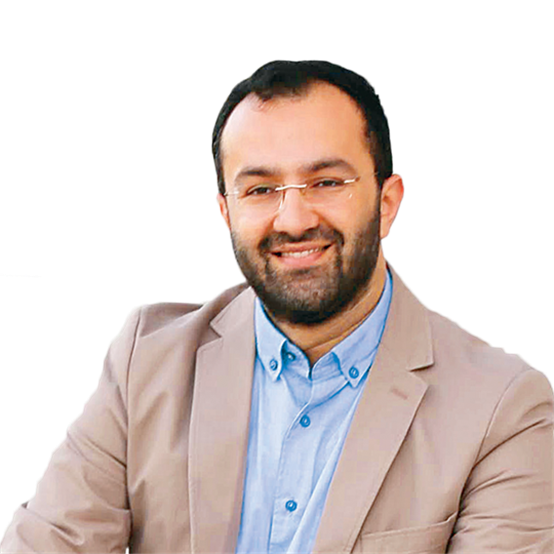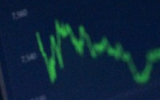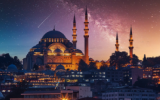
- 14.09.2025, Sunday
- 06:01
The other Cyprus...
23:1831/05/2025, Saturday
Next article
Taha Kılınç

I will never forget that evening: During our trip in the fall of 2008, wandering every corner of Cyprus with my dear brother Burak Bahadır Bilgin, we found ourselves in Lefke. At that time, finding an open—and suitably clean—mosque for prayer in Cyprus was no small matter. As we searched for a place to perform the evening prayer, we spotted a minaret in the distance and immediately turned the steering wheel in that direction. When we reached the mosque, a man in the son cemaat area was about to
I will never forget that evening: During our trip in the fall of 2008, wandering every corner of Cyprus with my dear brother Burak Bahadır Bilgin, we found ourselves in Lefke. At that time, finding an open—and suitably clean—mosque for prayer in Cyprus was no small matter. As we searched for a place to perform the evening prayer, we spotted a minaret in the distance and immediately turned the steering wheel in that direction. When we reached the mosque, a man in the son cemaat area was about to say the takbir. We stopped him and said, "Let’s pray together." He agreed and even had me lead the prayer.
After the prayer, introductions followed. He asked who we were and what brought us there. We answered. When we posed the same question to him, he replied with effortless ease, "I serve at a dergah." "Whose dergah?" we asked. His answer came just as naturally, along with an invitation: "Sheikh Nazım Kıbrısî. The dergah is right behind the mosque. The talk will begin soon. If you have time, you’re welcome to join." For such an extraordinary encounter, of course, we had time.
Up until then, I had often heard of Sheikh Nazım, tuning in to his striking style through television and newspapers. During my time in Damascus for Arabic studies, the tekke and tomb of Sheikh Nazım’s master, Abdullah Dağıstânî, were right beneath our home. I would occasionally visit there, so I had a distant familiarity with Sheikh Nazım. But this would be my first time seeing him in person.
The dergah was a living example of the classic scenes I had always read about in Sufi literature: After a humble meal where people of all colors and races shared from the same pots, we moved to a mosque reflecting the same diversity for the talk. Sheikh Nazım soon entered, supported by two disciples, and was seated in an armchair near the mihrab. My friend and I found spots in the middle of the crowd and sat down.
Just as he was about to begin, Sheikh Nazım swept his sharp, piercing gaze over the gathering, then locked eyes with me, pointed, and asked, "Who are you?" You can imagine my surprise. Instead of answering from my seat, I stood up, approached him, and knelt beside his chair. The crowd in the mosque and all the disciples watched the scene with even greater astonishment than mine.
For the next half hour, Sheikh Nazım kept asking me questions, and I answered. A private dialogue unfolded between us—some of his playful, pointed questions I answered in whispers—while the rest observed. Finally, as the call for Isha prayer signaled the transition to worship, the time allotted for the talk had melted away in our one-on-one exchange. Sheikh Nazım laughed and said, "Where did this guy come from?" On the way out, it was now my turn to take his arm and assist him.
While reading Prof. Dr. İsmail Güleç’s book "Kıbrıs’ın Manevî Atlası" (The Spiritual Atlas of Cyprus), published by the Presidency for Turks Abroad and Related Communities, I smiled upon reaching the section on "Sheikh Nazım al-Haqqani" (pp. 173–177), remembering the evening I just described. That 2008 trip, much like the one Prof. Güleç meticulously documents in his book, helped us see the "other" face of Cyprus—its tekkes and tombs revealing dimensions of the island we’d never encountered before.
Prof. Güleç, who served as rector of the Cyprus Social Sciences University from 2015 to 2017, is the author of the most detailed Turkish-language travelogues and guides on Cyprus. Beyond the aforementioned book, his "Lefkoşa Sur İçi Rehberi" (Nicosia Walled City Guide) and "Gazi Mağusa Gezi Rehberi" (Famagusta Travel Guide) are particularly invaluable. I must also mention the "Kıbrıs Gezi Rehberi" (Cyprus Travel Guide) he prepared for our magazine Derin Tarih in 2022. The feedback from a group of teachers who followed that compact yet precious booklet speaks volumes: "No one ever showed us Cyprus like this—we’d never seen it this way before. We’ve been missing out."
Cyprus, unfortunately etched in our memories only as a leisure and holiday destination, is in fact one of the key waypoints in our historical and spiritual map. This is precisely what Prof. Güleç emphasizes. While thanking our esteemed teacher for filling a major void in this field, I also wish to remind us all that recognizing and introducing the Other—the Essential—Cyprus is a duty we all share.
#Cyprus
#Islam
#Spiritual
#Mosque
LEGAL NOTICE
The BIST name and logo are protected under the "Protected Trademark Certificate" and cannot be used, quoted, or altered without permission.All rights to the information disclosed under the BIST name are entirely owned by BIST and cannot be republished. Market data is provided by iDealdata Financial Technologies Inc. BIST stock data is delayed by 15 minutes.






